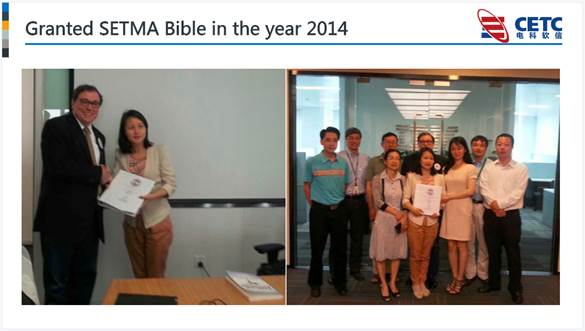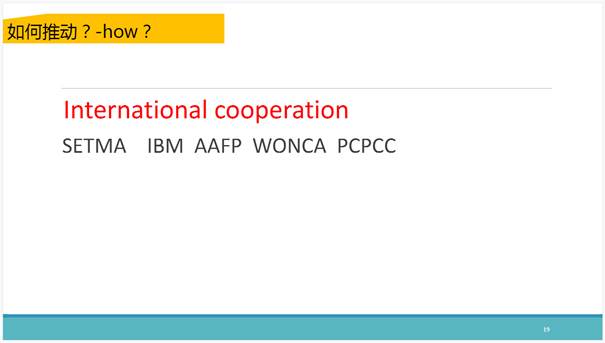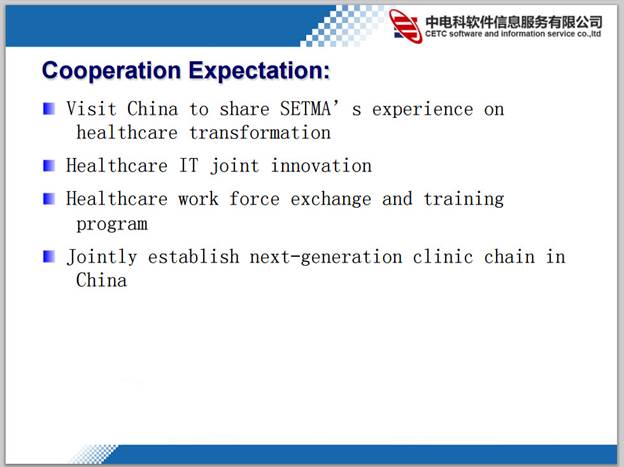|
Eric Liu | 
Dear Eric:
Rather than printing copies of the notebook which we prepared for the June, 2014 meeting of the first delegation from China, I am sending you the hyperlinks to the table of contents of the notebook from that visit. As everything on SETMA’s website is free for anyone to take and use, these materials can be reproduced for use in your work in China. The link below entitled, Table of Content and Meeting Agenda for June, 2014 Meeting, presents the meeting agenda and table of content for the notebook which includes hyperlinks to each section of the notebook.. Links at the bottom of this summary are to other articles about that visit.
The two attachments above are two slides from the presentations yesterday to SETMA. All three presentations can be reviewed at http://jameslhollymd.com/Letters/visit-by-chinese-delegation-of-5-their-presentations-to-setma. The pictures show a physician from China holding a notebook. This is the printed SETMA notebook prepared for the June, 2014 meeting. Of course the American in these pictures is Dr. Paul Grundy who is the “god father” of PC-MH in America and around the world. The other picture shows the international cooperation which has been developed which is, “SETMA, AAFP, IBM, WONCA (Chinese District Primary Care Demonstration) and PC-PCC.
Members of the Chinese Delegation told SETMA, that as they continue to build their new Primary Care foundation for expanding ambulatory healthcare in China, this notebook has become a key resource. The leader of the meeting yesterday told us that he has read the notebook from cover to cover over eight times. This is the link to the notebook content: http://jameslhollymd.com/Presentations/participants-and-notebook-contents-for-eight-member-chinese-delegation-visit-to-setma. The following are the hyperlinks to the Table of Content and Meeting Agenda for June, 2014 Meeting:
- SETMA and Electronic Patient Management
- SETMA's vision on future healthcare care
- How SETMA leverage evidenced-base medicine
- SETMA's Quality management and improvement system
- SETMA's experience on PCMH transformation
- SETMA's patient engagement strategy and experience
- Pubic Reporting by Provider Name at www.jameslhollymd.com - COGNOS
Where to from here?
The last slide of the first presentation to SETMA is entitled, “Cooperation Expectation.” It can be seen at http://jameslhollymd.com/Letters/pdfs/setma-healthcare-transformation-pilgrimage.pdf. This slide identifies four steps which are the hope of the Chinese Delegations for an on-going ten-year relationship with SETMA. They are:
- Visit China to share SETMA’s experience on healthcare transformation
- Healthcare IT Joint Innovation
- Healthcare Workforce Exchange and Training Programs
- Jointly establish a next-generation clinic chain in China
This is ambitious. The first step is for SETMA to review Process Analysis in healthcare transformation with our Chinese friends. (see: http://jameslhollymd.com/Your-Life-Your-Health/pdfs/process-analysis-and-how-many-tasks-can-you-get-a-provider-to-perform-at-each-encounter.pdf. We will do this virtually by the Chinese examining their workflow and identifying areas which can either be automated (see http://jameslhollymd.com/epm-tools/Automated-Team-Tutorial-for-the-EMR-Automated-Team-Function) or which can be done electronically by a healthcare team.
The Chinese will send SETMA their ideas about a process. We will review it and suggests how we would approach the issue. Together, we will design a new process which will improve primary healthcare in China. During our visit to China we will spend more time face-to-face developing this new skill set. We will also work on definition and deployment of teams in health in order to increase efficiency and excellence.
Two experiences at SETMA will be used to help prepare China for the transformative work which must be done.
The Joint Commission Accreditation for Ambulatory Care and PC-MH Conclusion about SETMA
Both the surveyors and one of the executives at The Joint Commission commented about the philosophical foundation of SETMA’s work. Wednesday afternoon (March 5, 2014) I called my executive contact at The Joint Commission. He said “I was just talking to one of my colleagues and showing him SETMA’s notebook which was prepared in response to The Joint Commission’s Standards and Requirements Chapter Seven o leadership.” The executive said, “Look at this; everything they do is founded upon a philosophical foundation. They know ‘what they are doing,’ but more importantly, they know why they are doing it.’” SETMA is not the result of random efforts but of innovations and advances which are consistent with a structured set of ideals, principles and goals.
This will be one of the major aspect of our collaboration for everyone in China to understand “why” things will be done differently. Once the “why” which is part of the vision is embraced, the “how” and the sustaining of the effort will logically follow. We will embed into the thinking of this collaboration, Peter Senge’s concept of “creative tension.” Senge said: “The juxtaposition of vision (what we want) and a clear picture of current reality (where we are relative to what we want) generates what we call ‘creative tension’: a force to bring them together, caused by the natural tendency of tension to seek resolution.”
With vision and passion, we will attempt to create “creative tension” in the Chinese healthcare systems. The genitive (creative” efforts to resolve that tension will transform the Chinese healthcare system.
Robert Wood Johnson Foundation LEAP Study conducted by the MacColl Institute
The fifth area of uniqueness of SETMA identified by the RWJF team was a surprise to them; it was SETMA’s IT Department. The RWJF team felt that SETMA has approached healthcare transformation differently than anyone they have seen. They related that uniqueness to the decision we made in 1999 to morph from the pursuit of “electronic patient records” to the pursuit of “electronic patient management.” They were surprised to see how centrally and essentially electronics are positioned into SETMA and how all other things are driven by the power of electronics. They marveled at the wedding of the technology of IT with clinical excellence and knowledge. The communication and integration of the healthcare team through the power of IT is novel, they concluded.
Technology is valuable but only if it compels excellence in healthcare delivery and outcomes performance. SETMA will share with the Chinese the processes which created this wedding between clinician and technician. Much of that is defined the in the ten principles SETMA identified in May, 1999 which are explained in the following article: http://jameslhollymd.com/Your-Life-Your-Health/pdfs/may-1999-four-seminal-events-in-setmas-history.pdf. The ten principles for transforming healthcare both electronically and philosophically are from Peter Senge’s The Fifth Discipline. In May, 1999, SETMA defined the principles which guided our development of an EHR and which defined the steps of SETMA’s transformation from an EMR to EPM (http://jameslhollymd.com/EPM-Tools/pdfs/designing-an-emr.pdf). These principles would also be the foundation of SETMA’s morphing into a patient-centered medical home (PC-MH). The principles were to:
- Pursue Electronic Patient Management rather than Electronic Patient Records
- Bring to every patient encounter what is known, not what a particular provider knows
- Make it easier to do “it” right than not to do it at all
- Continually challenge providers to improve their performance
- Infuse new knowledge and decision-making tools throughout an organization instantly
- Promote continuity of care with patient education, information and plans of care
- Enlist patients as partners and collaborators in their own health improvement
- Evaluate the care of patients and populations of patients longitudinally
- Audit provider performance based on endorsed quality measurement sets
- Integrate electronic tools in an intuitive fashion giving patients the benefit of expert knowledge about specific conditions
The first major undertaking will be to design tools for the transformation of diabetes care for China. That has already begun as the delegation has already begun to translate SETMA’s Diabetes Disease Management tool into Chinese.
And so, SETMA and our Chinese colleagues begin. No one knows were this will end but we all are willing to invest time and energy in a cause which is worthy of our efforts - improving healthcare for one-third of the world’s population.
James (Larry) Holly, M.D.
C.E.O. SETMA
www.jameslhollymd.com
Adjunct Professor
Family & Community Medicine
University of Texas Health Science Center
San Antonio School of Medicine
Clinical Associate Professor
Department of Internal Medicine
School of Medicine
Texas A&M Health Science Center



|